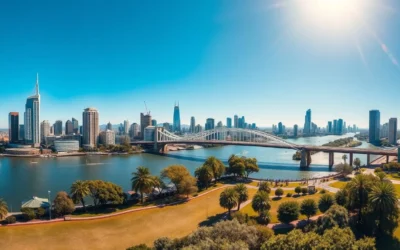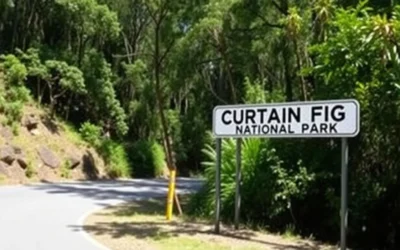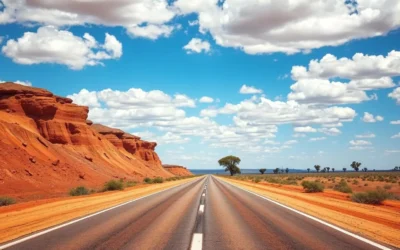Did you know that Boodjamulla National Park is home to fossils dating back 25 million years, making it one of the world’s richest mammal fossil sites? This emerald oasis in Queensland’s remote outback offers a startling contrast to the surrounding semi-arid landscape – a lush paradise of crystal-clear waters flowing through ancient sandstone gorges.
Known traditionally as Boodjamulla and formerly as Lawn Hill National Park, this 28,200-hectare wilderness area is one of Queensland’s most spectacular yet least-visited national parks. Located in the Gulf Savannah region, it’s a place where time seems to stand still, preserving both natural wonders and the cultural heritage of the Waanyi people who have called this land home for over 17,000 years.
Getting There & Planning Your Journey
Reaching Boodjamulla National Park requires some planning due to its remote location in northwestern Queensland. The journey itself is part of the adventure, taking you through classic outback landscapes.
By Air
The closest major airport is in Mount Isa, approximately 340 km (211 miles) southeast of the park. Regular flights connect Mount Isa with Brisbane (2.5 hours) and Townsville (2 hours).
Find the Best Flight Deals
Compare prices from major airlines to Mount Isa and start your outback adventure.
By Road
From Mount Isa, the drive to Boodjamulla takes approximately 4 hours (340 km) on mostly unsealed roads. A 4WD vehicle is highly recommended, especially during the wet season (November to April) when roads can become impassable.
The most common route is via the Barkly Highway to Camooweal, then north to Gregory Downs, and finally west to the park. Alternatively, if you’re coming from Cairns or the east coast, you can take the Savannah Way scenic drive.
Rent a Suitable Vehicle
A 4WD vehicle is recommended for the unsealed roads to Boodjamulla National Park.

Best Time to Visit & Weather Tips
The dry season (May to October) is the ideal time to visit Boodjamulla National Park. During these months, temperatures range from 10°C to 30°C (50°F to 86°F), with clear skies and minimal rainfall making it perfect for hiking, canoeing, and camping.
The wet season (November to April) brings heavy rainfall, high humidity, and temperatures between 25°C and 40°C (77°F to 104°F). Many roads become impassable during this time, and the park may close due to flooding. In fact, following extensive flooding in March 2023, parts of the park were closed until July 2025 for recovery.
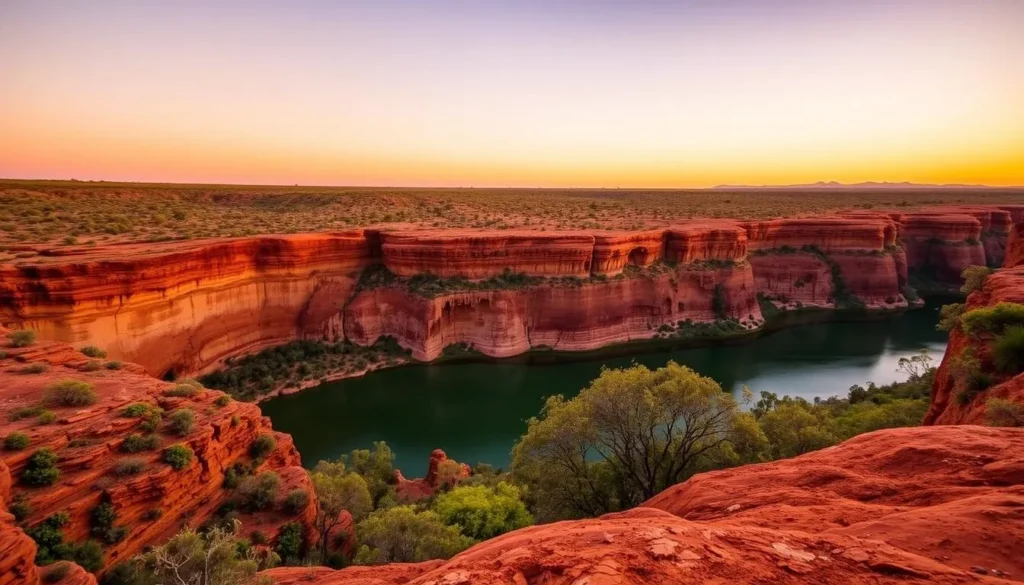
The best months to visit are June and July when days are warm and sunny (around 28°C/82°F) and nights are cool but not cold (around 12°C/54°F).
Getting Around Locally
Once you’ve arrived at Boodjamulla National Park, getting around is primarily by foot or canoe. The park is divided into two main sections: the Lawn Hill Gorge area in the north and the Riversleigh Fossil Fields in the south.
Walking Trails
The park features seven well-marked walking trails ranging from easy 20-minute walks to challenging 3-4 hour hikes. All trails start from the Lawn Hill Gorge camping area, making it an ideal base for exploration.
Island Stack Walk
2.6 km return (1.6 miles)
1 hour
Moderate difficulty
Offers panoramic views of the gorge from a sandstone plateau.
Upper Gorge Lookout
3.6 km return (2.2 miles)
2 hours
Moderate to difficult
Spectacular views of the upper gorge with steep sections.
Wild Dog Dreaming
4.5 km return (2.8 miles)
1.5 hours
Easy
Cultural site with Indigenous rock art and engravings.
Canoeing
Canoeing is one of the best ways to experience Lawn Hill Gorge. Canoes can be hired at the campground, allowing you to paddle through the emerald waters to Indarri Falls and beyond. The Middle Gorge and Upper Gorge sections are particularly scenic.

Book a Guided Tour
Explore Boodjamulla with knowledgeable guides who can enhance your experience with local insights.
Where to Stay
Accommodation options in and around Boodjamulla National Park are limited but sufficient for most visitors. Advance booking is essential, especially during the peak dry season.
Camping in the National Park
The Lawn Hill Gorge camping area offers 20 sites suitable for tents and small campervans (under 4m). Facilities include toilets, cold showers, and barbecue areas. Bookings through Queensland Parks are essential, especially from May to September.
For those exploring the southern section of the park, the Miyumba camping area near the Riversleigh Fossil Fields provides basic facilities with 10 sites.
Adels Grove
Located just 10 km from the park entrance, Adels Grove offers a range of accommodation options including camping sites, permanent tents, ensuite rooms, and cabins. The property features a restaurant, bar, and swimming areas in the creek.

Find Your Perfect Stay
Book accommodation at Adels Grove or nearby options in advance to secure your spot.
Dining & Local Cuisine
Dining options are limited in this remote area, so planning ahead is essential.
Self-Catering
Most visitors bring their own food supplies. The Lawn Hill Gorge camping area provides gas barbecues and picnic tables. There are no cooking facilities at the Miyumba camping area, so campers need to be fully self-sufficient.
Stock up on supplies in Mount Isa or Gregory Downs before arriving, as there are no shops in the park.
Adels Grove Restaurant
The restaurant at Adels Grove serves breakfast, lunch, and dinner daily. Dinner typically features a two-course set menu that changes daily. Booking is recommended during peak season.

For a special experience, join the sunset tour to Harry’s Hill from Adels Grove, which includes wine and cheese while watching the spectacular outback sunset.
Attractions, Sightseeing & Activities
Lawn Hill Gorge
The crown jewel of Boodjamulla National Park, Lawn Hill Gorge features stunning emerald waters flowing between towering sandstone cliffs. The gorge is divided into three sections – Lower, Middle, and Upper – each offering unique perspectives and experiences.
Don’t miss Indarri Falls, a beautiful tufa formation that separates the Middle and Upper gorges. The natural infinity pool at the base of the falls is perfect for swimming.

Riversleigh Fossil Fields
The World Heritage-listed Riversleigh Fossil Fields contain some of the richest mammal fossil deposits on Earth. A self-guided walking trail with interpretive signs explains the significance of this paleontological treasure trove where fossils date back 15-25 million years.
If you visit in early July, you might spot paleontologists conducting their annual dig.

Indigenous Cultural Sites
The Wild Dog Dreaming track leads to significant Aboriginal rock art sites. The Waanyi people have inhabited this area for at least 17,000 years, and their connection to the land is evident in the cultural sites throughout the park.
Experience Indigenous Culture
Book a guided cultural tour to learn about the rich Aboriginal heritage of Boodjamulla.
Wildlife & Natural Wonders
Boodjamulla National Park is a biodiversity hotspot, home to over 140 bird species and numerous native animals. The park’s varied habitats – from riverine corridors to rocky escarpments – support a rich diversity of wildlife.
Birdwatching
Birdwatchers will be delighted by the variety of species, including the rare purple-crowned fairy-wren (the park emblem), buff-sided robin, crimson finch, and various waterbirds. Early morning and late afternoon offer the best birdwatching opportunities.
Native Animals
Keep an eye out for freshwater crocodiles sunning themselves on the riverbanks (they’re shy and generally harmless to humans), wallaroos, rock-haunting ringtail possums, and short-beaked echidnas.

Flora
The park’s vegetation is surprisingly lush for an outback location. Along the waterways, you’ll find cabbage palms, pandanus, river red gums, and paperbarks. The sandstone hills support spinifex, acacias, and grevilleas, while the river plains feature western bloodwoods and mitchell grass.
Practical Travel Tips
What to Pack
- Plenty of drinking water (minimum 2 liters per person per day)
- Sun protection (hat, sunscreen, sunglasses, long-sleeved shirts)
- Insect repellent
- Sturdy walking shoes
- Swimming gear
- Camera with extra batteries
- First aid kit
- Food supplies (no shops in the park)
Safety Information
- Tell someone your plans before heading into remote areas
- Carry extra fuel and vehicle spares
- Stay on marked trails when hiking
- Swim only in designated areas
- Be aware of your surroundings when near the water (freshwater crocodiles)
- Carry sufficient water at all times
- Check road conditions before traveling
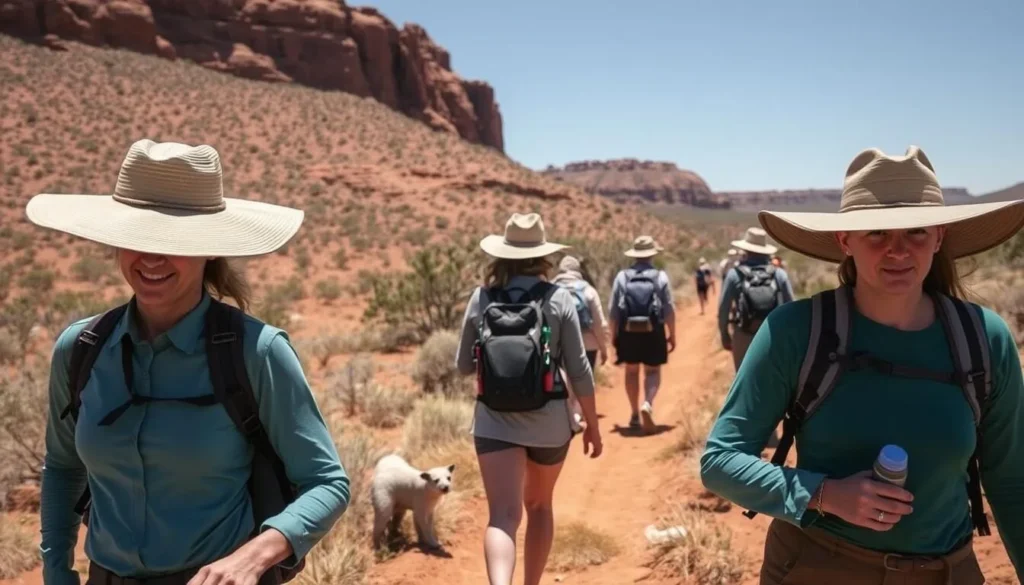
Permits and Fees
Camping permits are required for overnight stays in Boodjamulla National Park and must be booked in advance through Queensland Parks. Day visitors do not need permits but should register at the visitor center upon arrival.
Mobile Coverage: There is no mobile phone coverage in Boodjamulla National Park. Adels Grove has limited Wi-Fi available for guests. For emergencies, satellite phones are recommended.
Experience the Timeless Beauty of Boodjamulla
Boodjamulla National Park offers a truly unique Australian outback experience. From paddling through emerald gorges to hiking ancient landscapes and discovering prehistoric fossils, this remote wilderness rewards those who make the journey with unforgettable natural beauty and cultural significance.
Whether you’re seeking adventure, tranquility, or connection with Australia’s ancient past, Boodjamulla delivers an authentic outback experience that will stay with you long after you’ve returned home. Start planning your journey to this remarkable Queensland treasure today.
Ready for Your Boodjamulla Adventure?
Begin planning your trip to one of Queensland’s most spectacular national parks.
The above is subject to change.
Check back often to TRAVEL.COM for the latest travel tips and deals.


